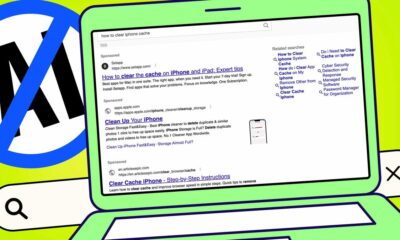MARKETING
A 4-Step Customer Journey Map Process for Better Content Results [Template]
![A 4-Step Customer Journey Map Process for Better Content Results [Template] A 4-Step Customer Journey Map Process for Better Content Results [Template]](https://articles.entireweb.com/wp-content/uploads/2022/04/1649081312_A-4-Step-Customer-Journey-Map-Process-for-Better-Content-Results.png)
Did you bring a map (digital or otherwise) with you on your last road trip? Most people do – It’s the best way to ensure that you arrive exactly where you intended to go.
Yet relatively few marketers create a map when planning content. They should. A customer journey map is a great way to lead prospects and customers to a destination that meets their information needs (and your marketing goals.)
The journey mapping process also can provide the strategic direction your team needs to know what kind of content to create to help move website visitors and other prospects through the sales cycle.
Though journey mapping can seem like a complex and tedious time suck, it doesn’t have to be.
A streamlined journey mapping process helped fintech company Datasite transform random acts of content into connected, customer-centric experiences.
Convince & Convert’s Jenny Magic worked with Datasite Vice President of Marketing Americas Marcio Moerbeck to create the company’s customer journey maps. Here’s a detailed walkthrough of the process they followed (and a template you can use to get started) from their presentation at Content Marketing World 2021.
Marcio and Jenny also explain why customer journey maps are a critical part of any content marketing strategy and what they can help your brand achieve in this short video:
What is a customer journey map?
A journey map is a visual representation of the customer journey that defines:
- All the points where customers and prospects interact with your brand
- What they want to accomplish at each one
- The path they take from point to point as they move toward a purchase
Jenny describes it as representing the intersection of buyer needs and your organization’s calls to action. “It’s thinking about what they need, what we need, what do we want them to do, and why would they want to do it. It helps content marketers get out of their own heads and see their brand through the eyes of customers,” she says.
Creating a customer journey map for your #ContentMarketing helps you see your brand through your prospects’ and customers’ eyes, says @JennyLMagic via @CMIContent @semrush. #CMWorld Click To Tweet
![A 4-Step Customer Journey Map Process for Better Content Results [Template] 1649081311 39 A 4 Step Customer Journey Map Process for Better Content Results](https://articles.entireweb.com/wp-content/uploads/2022/04/1649081311_39_A-4-Step-Customer-Journey-Map-Process-for-Better-Content-Results.png)
Journey mapping is a marketer’s “secret superpower,” Jenny says. “The intersection of your brand strategy, your personas, and your journey maps is true content marketing gold.”
Why create customer journey maps?
Viewing your brand’s value through that lens helps you evolve your content experience to become more customer-centric.
That’s particularly important because customers want to do their own research. According to TrustRadius research, 87% of buyers want to self-serve part or all of their buying journey, and 57% of buyers already make purchase decisions without ever talking with a vendor representative.
87% of buyers want to self-serve part or all of their buying journey, and 57% already make purchase decisions without talking with a vendor rep, according to @trustradius #research via @joderama @CMIContent @semrush. Click To Tweet
And they’re less patient with marketing that prioritizes the brand’s messages and goals over a useful and contextually relevant content experience.
“Every single content preference study gives marketers a thumbs down on whether or not the content is objective versus being biased; whether it is focused on substance over style; whether it’s the right amount of material or an overwhelming volume, and finally, whether or not it’s extraneous to their research,” Jenny says. “This means [marketers] are not doing a fantastic job telling them what they need to know to make that decision.”
Working through the mapping process keeps you focused on customers by:
- Enabling cross-team alignment around customer needs: The mapping process brings sales, marketing, and customer support together to define what customers need to know before they buy, what they need after they purchase, and the stories marketing can tell to support those interactions.
- Guiding content priorities: It’s easy for teams to get distracted by the next shiny object, the next social media channel, or some exciting idea from the C-suite. A journey map that clearly articulates audience needs helps ensure the team stays true to what your audience wants and needs.
- Inspiring customer-centric content. Auditing your content during the mapping process can reveal topic gaps you should create content to fill.
ADVERTISEMENT![A 4-Step Customer Journey Map Process for Better Content Results [Template] 1649081311 212 A 4 Step Customer Journey Map Process for Better Content Results](https://articles.entireweb.com/wp-content/uploads/2022/04/1649081311_212_A-4-Step-Customer-Journey-Map-Process-for-Better-Content-Results.png)
The State of Content Marketing 2022 Global Report
Looking to grow your business with content? Explore the ultimate blueprint for content marketing success: the State of Content Marketing 2022 Global Report by Semrush. 500K articles analyzed. 1,500 marketers surveyed. 9 industry experts surveyed. Download your free copy now!
HANDPICKED RELATED CONTENT:
A streamlined customer journey mapping process and template
Jenny recommends a customer journey process that focuses on a narrow set of information selected to help you plan more effectively and create higher-performing content.
I’ll walk you through the steps of this process, using a template Jenny built in Airtable to illustrate the steps (you can access her template here). You can use Excel, Google Sheets, or any other project management tool to create a similar tracker.
Step 1: Define your personas
Click to enlarge
List your customer personas in the first tab on the far left of this template and fill in their most important characteristics. Jenny’s example shows details for three personas (A, B, and C), including their job titles, who they report to, and their role in the decision-making process.
If you haven’t yet created detailed customer profiles as part of your content marketing strategy development, consider this quick-start personas guide.
For journey mapping, Jenny recommends including only those details that are relevant to the decision journey – mindset and motivation.
These are the must-have insights she includes:
- Triggers: What drives their interest in changing their current solution or taking action on a new purchase?
- Influences: Who or what influences them on decisions like this?
- Value proposition: Which of your advantages and benefits will resonate with them most?
- Motivations and frustrations: Why have they chosen to engage with your business, and what do they need to do or solve right now?
TIP: To avoid bringing unintentional biases into your work, don’t give your personas names. “If we use a gendered name like ‘Driven Daniel,’ we instantly picture a male, and that may not be [relevant] to the decision process,” Jenny says.
Don’t give gendered names to your audience personas because that can introduce unintentional biases in your #ContentMarketing, says @JennyLMagic via @CMIContent @semrush. #CMWorld Click To Tweet
Step 2: Define your calls to action (CTAs)
Click to enlarge
In the second tab, fill in your top 20 or so business CTAs – the activities that drive consumers toward a purchase decision.
Jenny says marketers tend to rush through this step or skip it entirely. But this step keeps content teams focused on desirable business outcomes rather than vanity metrics.
Think about these CTAs in terms of the behaviors you want to drive, such as:
- Assessing readiness to make a purchase decision
- Learning how to evaluate our type of solution
- Requesting a demo
Bring sales and customer support teams into your planning conversations to share insights and real-world scenarios at this stage.
“Sales might have a whole set of activities that they’re judged and rewarded on that are often very different from the [marketing team’s] CTAs – and very different from what the support team wishes our clients knew once they signed on the dotted line,” Jenny says.
She recommends bringing the teams together and getting them to agree on which CTAs to prioritize. Although this part of the process can feel arduous, Marcio confirms that it delivers important benefits: “The great moment of this exercise was that we came to a consensus on a set of CTAs that we can go and activate. Be patient and be resilient through that process because, for us, that was the win,” says Marcio.
Get sales, customer support, and marketing together to agree on which business calls to action to prioritize in your #ContentMarketing, says @JennyLMagic @AskMarcio via @CMIContent @semrush. #CMWorld Click To Tweet
Step 3: Define your customer experience
Once you’ve defined your audience targets and CTAs, use the Journey Map tab to align the persona details and journey stages with your content and CTAs. You can also fill in the emotions that likely drive your persona’s actions at each journey stage (as Jenny has done in this example). But don’t worry about the content column just yet – you’ll have that information once you do the audit in Step 4.
Click to enlarge
When filling in these fields, don’t nitpick every word choice or haggle over the fine details. Just summarize the essential information. In the remaining columns, Jenny recommends distilling your customer insights into answers to these four questions:
Think of this step as a narrative exercise that results in a first draft, Jenny says. It’s not meant to serve as a definitive resource to answer all your content planning questions.
Step 4: Audit your existing content
A comprehensive content audit is never a bad idea. But Jenny suggests speeding things up for journey mapping with this focused approach:
- List the titles of only your 50 highest-performing evergreen content pieces. They’ll serve as a representative sample of your best content.
- Determine which of your CTAs would be most relevant for each asset.
In Jenny’s full template (not pictured), you’ll see additional fields you can fill in if they’re important to your business (such as the asset’s URL, and target formats and channels).
But even if you just outline the content you have and the CTAs each one aligns with, the process will reveal two key content insights:
- Gaps: You’ll find out if you lack content for specific CTAs or topics. This insight will help you set priorities for future content creation.
- Waste: You’ll identify topics you’ve covered sufficiently (or more often than you need to). You can deprioritize these topics in your list of new content to create.
Transform random acts of content into connected customer experiences
These steps help you create the framework for a living content plan you can build on by adding more insights and ideas over time. As you brainstorm new content pieces or look for ways to refresh and repurpose the assets you’ve already created, use this template to set priorities and track results through your creation and distribution workflows.
Deciding what content pieces to create – and how to connect them to provide a seamless, customer-focused experience – can seem intimidating in the absence of a linear process. Try Jenny’s suggestions to help simplify your decision-making, increase your strategic focus, and achieve better marketing results.
Note: No one post can provide all relevant tools in the space. Feel free to include additional tools (from your company or ones you’ve used) in the comments.
Cover image by Joseph Kalinowski/Content Marketing Institute

![A 4-Step Customer Journey Map Process for Better Content Results [Template] 1649081311 96 A 4 Step Customer Journey Map Process for Better Content Results](https://articles.entireweb.com/wp-content/uploads/2022/04/1649081311_96_A-4-Step-Customer-Journey-Map-Process-for-Better-Content-Results.png)
![A 4-Step Customer Journey Map Process for Better Content Results [Template] 1649081311 942 A 4 Step Customer Journey Map Process for Better Content Results](https://articles.entireweb.com/wp-content/uploads/2022/04/1649081311_942_A-4-Step-Customer-Journey-Map-Process-for-Better-Content-Results.png)
![A 4-Step Customer Journey Map Process for Better Content Results [Template] 1649081311 482 A 4 Step Customer Journey Map Process for Better Content Results](https://articles.entireweb.com/wp-content/uploads/2022/04/1649081311_482_A-4-Step-Customer-Journey-Map-Process-for-Better-Content-Results.png)


















You must be logged in to post a comment Login